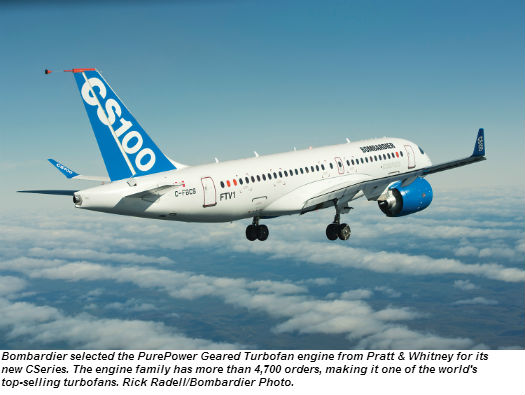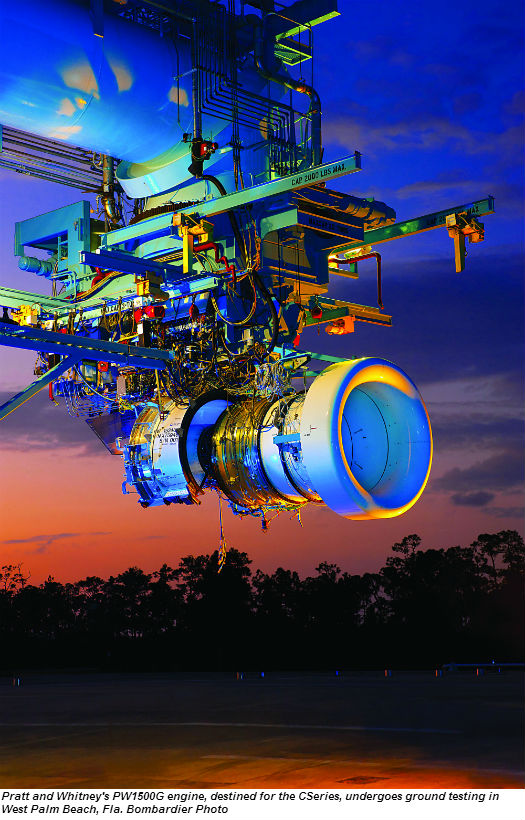The first flight of the Bombardier CS100 on Sept. 16 was a major milestone in the development of the new Pratt & Whitney (P&W) PurePower Geared Turbofan (GTF) engine family.
When the new jetliner lifted off the runway at Montreal’s Mirabel Airport, the sound of its two 23,000-pound thrust PW1500G engines was barely audible to the 3,000 spectators who witnessed aviation history.
The PurePower PW1000G family of engines represents a step change in technology, with their geared turbofans promising a double-digit improvement in fuel consumption, noise, environmental emissions and operating costs.
These benefits have caught the attention of five international aircraft manufacturers – Airbus, Bombardier, Embraer, Mitsubishi, and Russia’s Irkut -who’ve selected the 15,000 to 33,000 pound thrust PW1000G engine family to power their new 70-to-220 seat jets.
Record Orders
The numbers speak for themselves.
The PurePower Geared Turbofan engine family has more than 4,700 orders (that includes announced and unannounced firm orders plus options) as of early October 2013.
The payoff has come fast, with the PW1000G already ranked as one of the world’s top selling turbofans based on orders, even before it flew under its own power on the CSeries in September.
The Pratt & Whitney “Eagle” logo once graced thousands of engine nacelles when the JT8D turbofan ruled the skies, powering the Boeing 727, 737-100/200, McDonnell Douglas DC-9 and MD-80 families, as well as the French-made Caravelle and Mercure.
Then, in 1983, P&W joined the International Aero Engine (IAE) consortium – with Rolls-Royce, Japan Aero Engine and MTU Aero Engine – to produce the V2500 turbofan (for Airbus A320 and MD-90/Boeing 717), but it never achieved the success of the JT8D.
Now, P&W is making a strong comeback with the PW1000G and its 2012 buy-out of Rolls-Royce’s interest in the IAE collaboration.
Bombardier Challenge
Pratt & Whitney launched several programs to close a gap in its turbofan engine portfolio in the late 1990s.
At the time, Pratt & Whitney Canada’s (P&WC) most powerful turbofan was the 7,000-pound thrust PW300 for business jets, and the American parent was developing the 18,000 to 24,000 pound thrust PW6000 for the Airbus A318.
That’s when P&WC launched the Advanced Technology Fan Integrator (ATFI) project to help develop a 10,000 to 20,000 pound thrust geared-fan engine suitable for Bombardier’s proposed 100-seat BRJ-X regional airliner.
The BRJ-X was shelved, but Pratt & Whitney continued work on its geared-fan concept.
At the 2006 Paris Air Show, Bombardier announced its new CSeries passenger jet with the “game changing” Pratt & Whitney Geared Turbofan (GTF) as its engine choice.
Bombardier had challenged leading engine makers – CFM International (CFM56), International Aero Engines (V2500) and Pratt & Whitney (PW6000) – to develop a new centerline engine with a 15 per cent operating cost benefit over current designs.
As the winner of that challenge, Pratt & Whitney launched a geared turbofan demonstrator program to convince a skeptical airline industry of the new engine’s benefits. Ground demonstrations began in 2007, with the GTF fan and gearbox attached to a core based on the PW6000.
The GTF demonstrator engine flew for the first time on P&W’s Boeing 747SP in June 2008 at Plattsburgh, N.Y., and later Airbus gained firsthand experience flying the new engine on an Airbus A340 flight test aircraft in Toulouse, France.
PurePower Family
In July 2008, the GTF program was renamed “PurePower,” with two engine families in development sharing the same engine core.
Pratt & Whitney in East Hartford, Conn., led development of the 15,000 to 33,000 pound thrust PurePower PW1000G geared turbofan for airliners. Meanwhile, P&WC in Longueuil, Que., led development of the 10,000 to 20,000 pound thrust PurePower PW800 turbofan for large high-flying business jets, with the first model, the PW810C, intended for the Citation Columbus (which Cessna cancelled in 2009).
In the summer of 2010, P&W began testing a full scale PurePower engine core, incorporating a high-speed, low-pressure turbine and the first four stages of the high-pressure compressor developed by MTU Aero Engines of Germany.
Bombardier committed to the 19,000 to 23,000 pound thrust PW1500G for the 110-seat Bombardier CS110 and 130-seat CS130 when the CSeries was launched in June 2008 (after a two-year delay).
In fact, Mitsubishi Aircraft was actually the first airframe maker to sign a contract for the PW1000G, in October 2007, when it selected the PW1200G to power the brand new 70-to-90 seat Mitsubishi Regional Jet (MRJ).
Final assembly for the PW1500G engines will be at Pratt & Whitney Canada’s Mirabel Aerospace Centre in Mirabel, Que., which is now home to P&W’s two Boeing 747SP flight test aircraft, previously based in upstate New York.
The first flight of the PW1523G for the CSeries was in June 2011, on the inner pylon of one of the Boeing 747SPs. All engines for the CSeries have a 73-inch diameter fan and 12:1 bypass ratio.
For safety reasons, the lower power 15,000 to 17,000 pound thrust PW1200 began flight testing in mid-2012 on a ‘stub wing’ attached to the fuselage of the second Boeing 747SP. The engines for the MRJ have a 56-inch diameter fan and 9:1 bypass ratio.
Next on board was Irkut of Russia, in June 2012, when it selected the 28,000 to 31,000 pound thrust PW1400G to be the primary powerplant of the new MC-21 airliner, now expected to fly in 2015.
Airbus and Embraer
Pratt & Whitney has also been successful at knocking rival engines “off the wing” of existing aircraft designs.
In December 2010, Airbus announced development of the Airbus A320Neo (New Engine Program) and selected both the Pratt & Whitney 23,000 to 32,000 pound thrust PW1100G-JM (with an 81 inch fan and 12:1 bypass ratio) and the CFM International LEAP-X as new engine options.
And then, in January 2013, Embraer announced the PW1000G will power the “second generation” E-Jet, using the 15,000 pound thrust PW1700 and 22,000 pound thrust PW1900 to power new E170 and E190 models, respectively.
The new engines will allow the A320 and E-Jet models to fly further or carry more payload with the same amount of fuel.
New Technology Benefits
The $1 billion GTF development program draws on technology developed in the U.S. and Canada, as well as from MTU Aero Engines in Germany.
Pratt & Whitney says the geared turbofan will provide a 16 per cent reduction in fuel burn and a 20 per cent reduction in engine operating costs, compared to conventional turbofans.
This double-digit improvement in operating economics should significantly improve route and airline profitability (and payload/range) in today’s high fuel prices and low fare market.
On most turbofans, the fan and turbine rotate at the same speed on a direct drive shaft, while most turboprop and turboshafts have a gearbox.
The PW1000G architecture incorporates a 3:1 reduction gearing in an 18-inch diameter planetary gearbox (with seven moving parts) that allows the fan and low-pressure compressor and turbine to each rotate at an optimum speed.
The PW1000G fan has a larger diameter and rotates slower than on a conventional turbofan, while the low-pressure compressor and turbine rotates at a much faster rate, “supercharging” the air entering the high pressure compressor (which now requires fewer stages, saving parts and weight).
In short, the PW1000G delivers more thrust for less work.
The PW1000G’s low fuel consumption will also reduce carbon emissions by 3,000 tonnes per aircraft per year, says P&W, and its TALON X combustor will reduce NOx exhaust gas emissions to 50 per cent of the most stringent international standards (CAEP/6).
The slow turning fan also reduces an aircraft’s noise footprint by 50 to 75 per cent, allowing aircraft to operate 15 to 20 decibels below today’s most stringent standard (ICAO Stage 4).
Meanwhile, Pratt & Whitney Canada continues to develop the PurePower PW800 engine to ensure the technology is ready to support the next generation of aircraft in the large cabin business jet segment.



